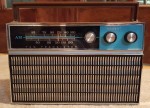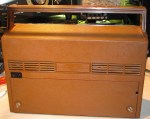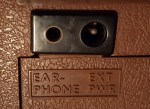Sears Silvertone – 6223-6224-6225
(And a look at the 3223-4223 series and Silvertone 800/900 Variants)
 Sears Silvertone – Models 6223 (Tan) – 6224 (Olive Green) – 6225 (Black)
Sears Silvertone – Models 6223 (Tan) – 6224 (Olive Green) – 6225 (Black)
Here’s another great old radio which I had never seen before that was recommended to me by a reader. I can’t tell you how many such recommendations I receive, and although I have discovered many exciting old and new old radios to check out, often they are disappointments. This time though it was a pleasant surprise.
I haven’t owned more than one or two small Sears portables over the years and Sears is not a brand I have read much about in regards to transistor radios, so I was pretty much starting out with zero knowledge, trying to piece together as much information as I could from the internet. I found the SAMS Service Manuals on these radios which also provided the date info on them.
 The 528 prefix of the chassis numbers denotes the manufacturer but I was not able to definitively find info on it. However, I did find that some or all Sears transistor radios of that era were made by a company called Warwick which later became part of a Sanyo manufacturing facility.
The 528 prefix of the chassis numbers denotes the manufacturer but I was not able to definitively find info on it. However, I did find that some or all Sears transistor radios of that era were made by a company called Warwick which later became part of a Sanyo manufacturing facility.
 There were many Silvertones over the years – for this article I am focusing on a 10-transistor design made around 1966 and comprising three models: 6223/4/5 with Chassis 528.63130 or 528.63131. I have also discovered an older Silvertone 800 from 1963/1964 which is a completely different radio – an 8-transistor design consisting of models 3223/4/5 with Chassis Numbers 528.54340/341/342 and models 4223/4/5 with chassis 528.54710/1. (There’ll be a quiz on these model numbers at the end…just kidding)!
There were many Silvertones over the years – for this article I am focusing on a 10-transistor design made around 1966 and comprising three models: 6223/4/5 with Chassis 528.63130 or 528.63131. I have also discovered an older Silvertone 800 from 1963/1964 which is a completely different radio – an 8-transistor design consisting of models 3223/4/5 with Chassis Numbers 528.54340/341/342 and models 4223/4/5 with chassis 528.54710/1. (There’ll be a quiz on these model numbers at the end…just kidding)!
All of these have a tuned rf stage and a large air variable tuning condenser for great performance and are powered by 6 D cells which will provide 450 hours or more battery life with alkaline cells given the low current drain of only 15 – 30 ma (30 ma at normal volume). The 1966 model also has DC input and earphone jacks on the back panel plus an AM antenna terminal inside the battery compartment. Housed in an unassuming plastic cabinet, this is a heavy radio and appears to be very well made. Its chromed front panel looks very much like the 1960’s with its retro style complimented by a large, easy to read dial scale. The 6223 appears solid yet basic with only three controls: Tuning, Tone, and On/Off Volume.
 My unit arrived working somewhat but was clearly in need of some basic cleaning and adjustment. The dial accuracy was off a bit and the sound, while OK, seemed a bit thin. There had been some leakage in the battery compartment but access was easy and I was able to disassemble the battery box contacts from the plastic part of the box which made cleaning them much easier. I used a thick paste of baking soda and water on Q-Tips, giving the paste lots of time to work, and after that I used some fine steel wool as well. Luckily, enough metal remained so they are now rust-free and reliable. The controls needed cleaning as well but responded perfectly…one treatment and each became smooth and solid. I always recommend Caig De-Ox-It for this as it is sometimes more effective than other control cleaners, but most any control cleaner will probably work fine.
My unit arrived working somewhat but was clearly in need of some basic cleaning and adjustment. The dial accuracy was off a bit and the sound, while OK, seemed a bit thin. There had been some leakage in the battery compartment but access was easy and I was able to disassemble the battery box contacts from the plastic part of the box which made cleaning them much easier. I used a thick paste of baking soda and water on Q-Tips, giving the paste lots of time to work, and after that I used some fine steel wool as well. Luckily, enough metal remained so they are now rust-free and reliable. The controls needed cleaning as well but responded perfectly…one treatment and each became smooth and solid. I always recommend Caig De-Ox-It for this as it is sometimes more effective than other control cleaners, but most any control cleaner will probably work fine.
 Several of the electrolytics needed replacement so since it was apart, I decided to replace all 7 of them. I almost installed the first one backwards because the original caps are marked with what looks like the usual line on one side, but then I saw that it was marked +. I’ve seen many old caps marked with a dot on the plus side but modern caps are marked with a stripe on their negative side. Lesson Learned – never take anything for granted.
Several of the electrolytics needed replacement so since it was apart, I decided to replace all 7 of them. I almost installed the first one backwards because the original caps are marked with what looks like the usual line on one side, but then I saw that it was marked +. I’ve seen many old caps marked with a dot on the plus side but modern caps are marked with a stripe on their negative side. Lesson Learned – never take anything for granted.
Finally, I went through the alignment procedure and although most of the adjustments were fairly close a few were far enough off that the final result was a noticeable improvement in sensitivity, selectivity and dial accuracy. The recapping also helped the audio and reception considerably. In fact, I am impressed by the sound of this radio and it is one of my better sounding large AM portables. It only has a single tone control but its range is very useful and the radio has a nicely balanced tone quality. The apparent AM bandwidth is a bit on the wide side, similar to other AM radios of the period such as the GE P780 series and Zenith 700 series lunchbox radios. This allows good clarity for AM with good, if not razor-sharp selectivity. Program listeners will love this radio for its natural audio and still-reasonable selectivity.
 AM sensitivity is very good but not top tier and that is almost undoubtedly due to the 6” ferrite rod antenna…a shame too since an 8” rod would have easily fit in a radio this large and it would have given a boost in raw sensitivity. As it is it is not shabby at all…I put it up against my top-rated GE SR I and SR II and the Silvertone was reasonably close to them. On extremely faint signals (at the threshold of intelligibility) the Superadios were a bit clearer, but in most cases the differences, while there, were more subtle. After several days of testing and comparing the 800 side by side with many other radios such as the GE’s and Zeniths I mentioned earlier I finally pegged the Silvertone at 4 Stars (Out of 5) which is still very good.
AM sensitivity is very good but not top tier and that is almost undoubtedly due to the 6” ferrite rod antenna…a shame too since an 8” rod would have easily fit in a radio this large and it would have given a boost in raw sensitivity. As it is it is not shabby at all…I put it up against my top-rated GE SR I and SR II and the Silvertone was reasonably close to them. On extremely faint signals (at the threshold of intelligibility) the Superadios were a bit clearer, but in most cases the differences, while there, were more subtle. After several days of testing and comparing the 800 side by side with many other radios such as the GE’s and Zeniths I mentioned earlier I finally pegged the Silvertone at 4 Stars (Out of 5) which is still very good.
So all in all I like this radio. It is old-school analog with a nice, big dial scale and is a great band scanner. It has strong reception and audio quality. It is also easy to service and well made. Be prepared though to replace the electrolytics. Generally, I’ve found that some models usually need new caps while others don’t, due to the particular electrolytics originally used. My radio needed new ones so it’s a safe bet many will, but luckily service access is easy. With that caveat in mind I give my thumbs up to the 1966 Sears Silvertone 800 Models 6223 (Tan) – 6224 (Olive Green) – 6225 (Black)
Jay Allen
Addendum for Silvertone 800 Models 3223/4/5, with Chassis Numbers 528.54340/341/342 and nearly identical Silvertone 900 Models 4223/4/5 with chassis 528.54710/1. Again, the different versions of each model represent different cabinet colors and minor chassis revisions. Interestingly, there is only one SAM’s Service manual for all 6 of these variants, and the only differences among the models noted in the manual are cabinet parts and the dial scale. Yet my radios use a few different components here and there…I would imagine these were addressed in the original service manuals or service bulletins at the time.
After I had gotten the 1966 Silvertone working, I found a 1963/1964 version which is a more traditional looking radio. Whereas the blue area on the front panel makes the 6223 look like 1960‘s modern, the 3223/4223 has a more conservative appearance. It is a completely different design inside and out, but it still has the tuned RF stage and large air variable tuning condenser.
My 3223 is the Tan version and the front panel says Silvertone 800. I later found a 4224 in Black which says Silvertone 900 on the front panel. Same radio inside. I recapped both of these radios and found they don’t seem quite as sensitive as the 6223 I got first.
Revision 2 – Still Another Silvertone Variant: (Pictures below) I recently acquired another version of these radios, Models 42331 Tan, 42241 Ivory and 42251 Black. This radio looks almost identical to the Models 3223 and 4223 series but is a different 9 transistor design…these were sometimes referred to as Silvertone 800 or 900 models. The service manual for the 3223/4223 models will serve for the 42231 series in terms of basic layout and alignment although it would have a different schematic and parts list. Note that the two radios in this picture are different models…one is an 8 transistor model probably one of the 3223 or 4223 series. The 42231 shown in black has 9 transistors. Neither of these completely matches the picture in the 1964 Sears catalog which says Silvertone 900. There are so many variations on these radios it’s tough to keep them all straight.
My 42251 needed no recapping so all I had to do was clean it up and align it (it was quite close to begin with). After I was done, I compared it with my 6223 which I reviewed above and found that although they sounded very similar on many stations there was decidedly less sensitivity on the 42251…weaker signals were just noisier and further away sounding. I don’t know if circuit changes were responsible for this or it is just a less-than-average sample which is possible. If I ever get another one I will update this.




You must be logged in to post a comment.